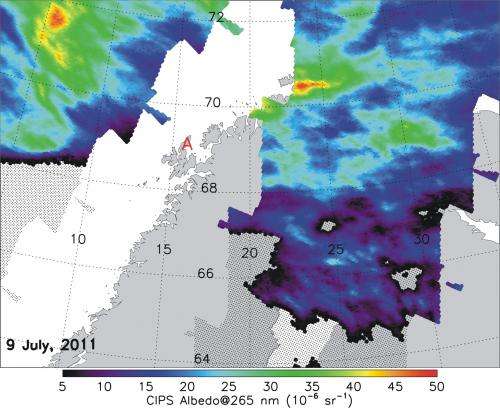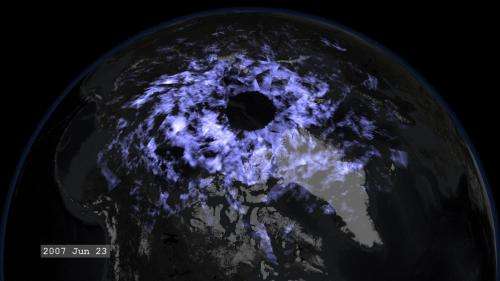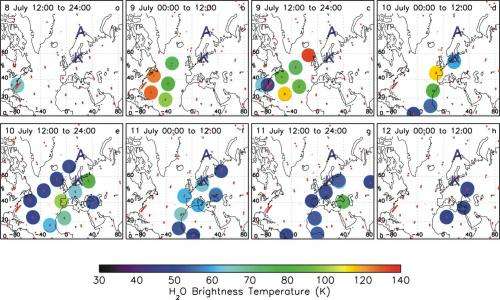Researchers observe bright Arctic clouds formed by exhaust from final Space Shuttle launch

(Phys.org)—Naval Research Laboratory (NRL) scientist Dr. Michael Stevens is leading an international consortium of scientists in tracking the rapid transport of the exhaust plume from the final launch of the space shuttle in July 2011. The team has found that the plume moved quickly to the Arctic, forming unusually bright polar mesospheric clouds (PMCs) there a day after launch.
Understanding the rapid transport of high altitude exhaust plumes near 105 km is providing new insight into the effects of winds at the bottom edge of the space weather regime towards improved forecasts of the co-located E-region of the ionosphere. This knowledge is critical for improving models of communication signal propagation and over-the-horizon-radar, explains Dr. Stevens, a Research Physicist in NRL's Space Science Division. Current theories suggest that the plumes are rapidly transported because of narrow, high-speed wind shears. These wind shears are also linked to the occurrence of so-called Sporadic E events, thus establishing a possible link between plume transport and the lower ionosphere.

During every launch, the space shuttle injects about 350 tons of water vapor from its three main engines off the east coast of the United States between 100 and 115 km altitude. Many studies have now shown that the poleward transport of this water vapor is much faster than global-scale models predict, and a few have furthermore shown that bursts of PMCs near 83 km altitude can result. These observations are forcing researchers to reexamine their understanding of global wind patterns in the lower thermosphere.

The long-term PMC record is also likely to be modified by increased space traffic, which is important because PMCs have been implicated as indicators of upper atmospheric climate change, explains Dr. Stevens. By assembling a suite of satellite and ground-based observations following the space shuttle's final launch, the NRL-led research team has revealed the nature of these shuttle clouds for the first time. The observations from both European and American collaborators show not only the rapid poleward transport of the plume and ensuing PMC formation, but that shuttle clouds are brighter than over 99% of all other PMCs and that the ice particles are larger at higher altitudes, which is the opposite of conventional models.
By allowing researchers to distinguish the shuttle PMCs from more typical clouds, these results will ultimately enable a search of the historical record to separate the anthropogenic PMCs from the natural PMCs.
More information: The research results are reported in a paper in press that was posted on the website of the Journal of Geophysical Research or August 27, 2012.
Journal information: Journal of Geophysical Research
Provided by Naval Research Laboratory




















